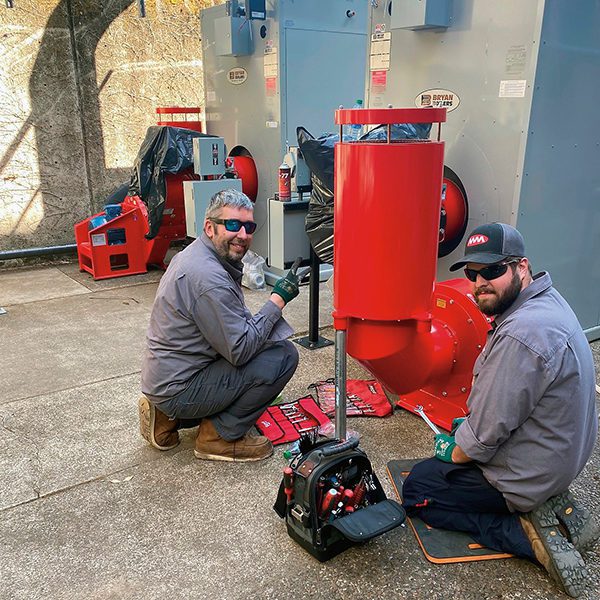Bringing the work to a boil
Special Services Projects
:+ : By Gabriel Hoy & Chris Griffiths
Customers with large central plants understand the complexity involved when it’s time to replace aging boilers. Central plants often feed critical operations areas for a building, which means the systems can’t be shut down during the upgrades and repairs. Such was the case for our recent project in Corvallis, Oregon.
The goal was to create a new boiler plant that would have greater efficiencies and provide a higher level or redundancy to their system. First, we had to create a temporary heating water system during construction to maintain system operation. We removed a 600 HP and 200 HP boiler and left one 600 HP boiler in place (which was still worth hanging on to as a redundant backup boiler). We installed four new 200 HP Bryan boilers with Limpsfield Autoflame burners and upgraded their entire flue system.
Their heating hot water pumping system was upgraded with a cleaner install of pumps with modern flow control that maintained their pump redundancy, and subsequently allowed the facility to eliminate their antiquated system bypass. Their backup fuel oil pump system was also upgraded. We replaced their makeup air unit and added a separate supply fan to ensure that it carried a level of redundancy to match the rest of the heating hot water plant. All of these upgrades set the facility up with enhanced control, higher reliability, and improved system efficiency.
Sounds easy, right?
Well, in reality, this project presented many conceptual and logistical hurdles along the way. To start, we were working with a mechanical room that had many kinds of systems in the space which could not be removed, shifted, or interrupted at any time during construction. There was a lot of piping, conduit, duct, equipment, and structure in the way, and the mechanical room was also buried within the bowels of the facility, which constrained the removal of large, old equipment and installation of new. The new flue was difficult to integrate because there were so many obstructions within the room to navigate, and we also had to feed the new flue system through multiple stories of an abandoned chimney stack.On top of all of that, this is an active heating hot water plant serving a working system which both needed to remain operational and maintain redundancy during all of construction! Since our design inherently had redundancy built in, we were able utilize a portion of the new boilers to create the temporary system and systematically cut the system over to the new system to avoid any downtime.
This was a total team effort from design to construction, including intense schedule and design coordination and we were able to pull off the cutovers with no issues. The entire team on this project demonstrated the high standards that MacDonald-Miller is known for.
Our boiler team led by Scott Gideon contributed invaluable knowledge and technical expertise all through the sales, design, coordination, and construction phases. Our fitting team led by Gene Cannon provided great constructability feedback during design, pulled off some incredibly difficult hot-taps, and managed a complicated temporary heating hot water plant to keep the entire building online even during demolition and installation. Our sheet metal team led by Andy Ottosen installed a complicated manifolded flue system and upgraded makeup air system. Our engineering team led by Jeff Welter played a crucial role in managing the design of complex existing and new systems, coordinating intricate project phases, and taking on a pivotal logistics role between engineering, sales, field, and customer. Brent Campbell, Oregon’s Operations Manager, provided constructability advice throughout and critical guidance to help the team safely integrate our new flue system with the existing composite-lined steel chimney system.
Read more from our latest Perspective Newsletter
